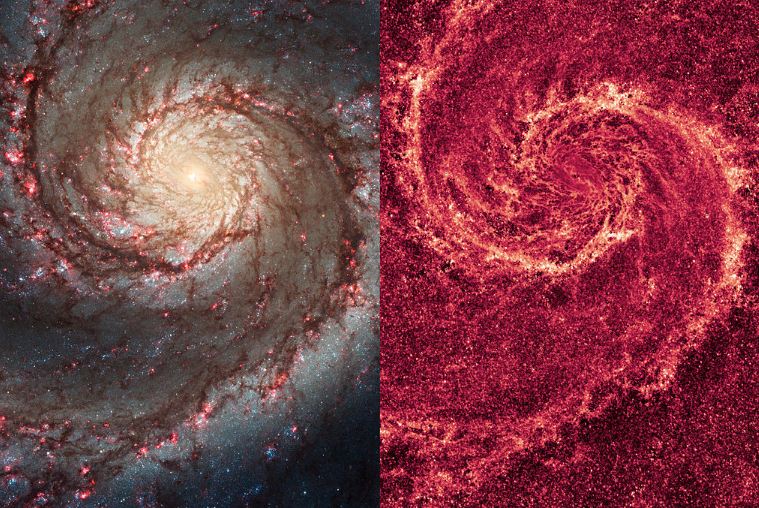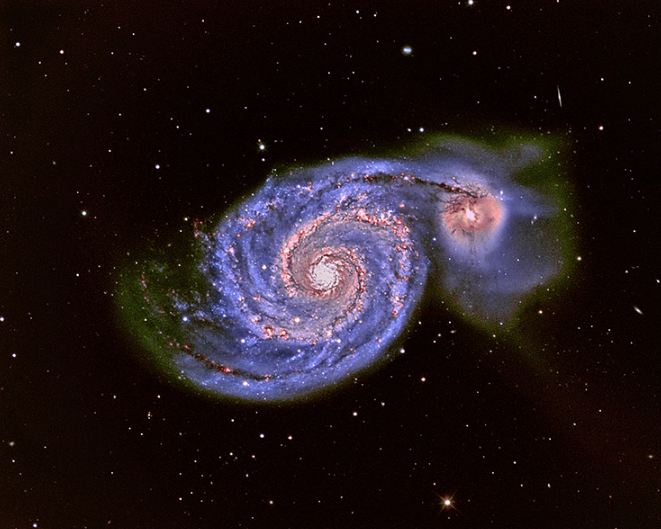On October 13, 1773, while Charles Messier was hunting for celestial objects, he found this spiral galaxy full of beauty with its graceful and winding arms appearing like a grand spiral staircase sweeping through space. It was called M51 or known as Whirlpool galaxy. Its arms are actually stars and gas laced with dust forming lanes.
Such striking arms are a feature of so-called grand-design spiral galaxies. These arms are not just for aesthetic purposes for spectators or astronomers, but they also serve as star-formation factories, compressing hydrogen gas and creating clusters of new stars.
A supermassive black hole, comparable to the one at the heart of the Milky Way, lies at the center of the Whirlpool Galaxy. The black hole at the center of the whirlpool is surrounded by dust rings that are constantly generating new stars. The Whirlpool has enough activity to be classified as a Seyfert galaxy by astronomers.
Some astronomers theorized that the galaxy’s arms are particularly prominent because of a close encounter with the small, yellowish galaxy at the outermost tip of one of the arms -the NGC 5195. This compact galaxy appears to be tugging on the arm due to the tidal forces that trigger new star formation.
A view from the Hubble Space Telescope shows that NGC 5195 passes behind M51, and this small galaxy has been gliding past the Whirlpool for hundreds of millions of years.
Visibility
Perhaps one of the best things that technology benefits humans is the help devices to see the seemingly impossible objects such as binoculars to observe the stars and other celestial objects in the night sky.
The Whirlpool galaxy is about 31 million light-years from Earth in the constellation Canes Venatici just southeast of the Big Dipper. It has an apparent magnitude of 8.4 and can be spotted with a small or a beginner’s telescope most easily during May. Its beautiful face-on view and the close distance to Earth allow astronomers to study a classic spiral galaxy’s structure and the star-forming processes.
According to NASA, M51 or NGC 5194, the Whirlpool galaxy is noted as “one of the brightest and most picturesque” ones people can see, and the Space Telescope Science Institute (STScI) even calls it one of “astronomy’s galactic darlings.” One of the galaxy highlights among astrophysicists is the abundance of supernovas (star explosions) recorded in recent years. One of the galaxy’s observed features is the significant closeness to companion galaxy NGC 5195, which may affect its structure.
Early Observations
In 1781, Pierre Méchain discovered a companion galaxy, NGC 5195. However, there was no study or observation about whether there is an interaction with M51 or merely another galaxy passing at a distance. Additionally, William Parsons, in 1845, 3rd Earl of Rosse, employing a 72-inch (1.8 m) reflecting telescope at Birr Castle, Ireland, found that the Whirlpool possessed a spiral structure, the first “nebula” to be known to have one.
Because it will eventually be totally absorbed by M51, or Messier 51, named after its discoverer, the dwarf galaxy companion to the Whirlpool Galaxy was given the title M51b. M51a and M51b are not yet totally fused, and a dust and gas bridge connects them.
These “spiral nebulae” were not recognized as galaxies until Edwin Hubble was able to observe Cepheid variables in some of these spiral nebulae, which provided evidence that they were so far away that they must be entirely separate galaxies even though they are seen close together.
Eventually, with the advent of radio astronomy, and the subsequent radio images of M51 undeniably proved that the Whirlpool and its companion galaxy are indeed interacting.
Supernova Bonanza
Supernovas are abundant in the Whirlpool in recent years. Skywatchers have noted them in 1994, 2005, and 2011. NASA says that three supernovas in 17 years is a lot for a single galaxy, and the reasons for the supernova surge in M51 are still being argued.
SN 2011dh is the latest supernova recorded, with its brightest view found in June 2011 before slipping back into obscurity. Astronomers scoured older pictures after the event had happened to find out if they could find the source of the explosion. Through a Hubble Space Telescope, they narrowed their search to a yellow supergiant star visible before the explosion but disappeared afterward.
According to NASA’s team, there is a possibility that the supergiant star was a binary star, and most yellow supergiants aren’t expected to go supernova when they finish out their lives. The yellow supergiant would have been pulled by some bluer, hotter star that was close enough and stronger to pull the yellow supergiant’s mass away. Given enough time, this would have destabilized the star and caused the explosion.
Recent Whirlpool Galaxy Finds
With the rise of inexpensive and powerful camera equipment, the Whirlpool is becoming a popular target for amateur astronomers.
In 2015, NASA released an image from the Chandra X-Ray Observatory that captured over 250 hours of observation time of the Whirlpool galaxy. The space telescope observed 500 X-ray sources in the galaxy’s region, racking up about five times the number of sources observed in previous studies. At least 10 of these sources are believed to come from black holes.
Close Encounter of the Galactic Kind
The arms of the Whirlpool galaxy are one of the most visible in spiral galaxies. This could be due to a “near encounter” with its sister galaxy, NGC 5195, as described by the researchers.
The gravitational muscle of NGC 5195 cranks up waves within the Whirlpool’s pancake-shaped disk as it floats by. The waves are similar to ripples in a pond caused by a rock tossed into the water.
When the waves pass across the disk’s circling gas clouds, the gaseous material along every arm’s inner edge is squeezed. The dark, powdery substance appears to be forming storm clouds. These dense clouds disintegrate, leaving a trail of star birth in their wake.
The largest stars would then burn away the surrounding gas over time, leaving only blue star clusters visible in the Whirlpool’s arms. More broadly, the galaxy’s proximity allows astronomers to study its structure and how stars develop, with the goal of transferring that knowledge to other galaxies.




